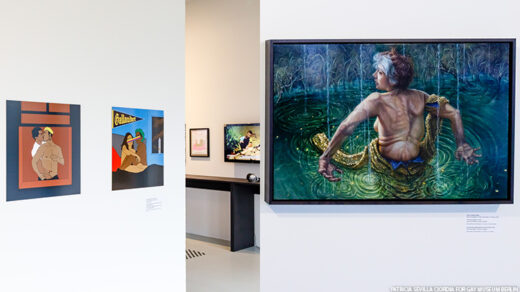Uma Thurman, Samuel L. Jackson Mix Art and Crime in Gay Director Nicol Paone’s ‘Kill Room’
Author: Trudy Ring
Shout! Studios
Hillary Clinton helped Nicol Paone become a film director.
And while the revered presidential candidate is a far cry from the morally compromised art dealer at the center of Paone’s new film, The Kill Room, they’re both strong, resourceful women — the type of women whose stories the out director seeks to tell.
The Kill Room, which opened in theaters Friday, stars Uma Thurman as Patrice Capullo, a glamorous but broke New York City gallery owner who can’t get through the day without some Adderall. She’s desperate for cash and for a way to attract wealthy customers. She finds both when, through her drug dealer, she meets Gordon Davis (Samuel L. Jackson), a bialy baker with connections to organized crime. He proposes using her gallery in a money-laundering scheme, and she accepts, making payments to a mob operative look like art sales and taking a cut.
However, she has to have some art to show to make it all seem legitimate — so the operative, Reggie Pitt (Joe Mangianello), starts cranking out paintings and other creations (of a sort) and becomes known as The Bagman, the next big thing in cutting-edge art. Patrice thinks at first he’s simply another drug dealer and is shocked when she learns he’s a hit man — but she soon takes the situation in stride and handles it in creative ways. Along the way, the dark comedy satirizes some aspects of the art world, such as collectors who’ll believe anything is great art if you tell them it is, and pretentious and powerful critics.
The Kill Room is Paone’s second feature as a director, the first being 2020’s Friendsgiving. Paone, a gay woman, had extensive writing and acting experience, especially in comedy with the Groundlings, Funny or Die, and The Big Gay Sketch Show, before working on a short film for Clinton’s 2016 presidential campaign — a project that led her into directing.
She had written the film, but the director didn’t show up, so she got the job of directing it. She was “incredibly nervous,” she recalls, but says that afterward, “It was like a light bulb went off — my brain is built for directing. I wanted to be part of the entire process of filmmaking.” (In response to a query about Clinton, Paone says she had limited contact with her, but she did work closely with the candidate’s campaign chair, John Podesta.)
She both wrote and directed Friendsgiving, a comedy about a chaotic Thanksgiving dinner, but on The Kill Room, she worked from a screenplay by Jonathan Jacobson. The script came to her through a former producing partner who was friends with him. Paone liked the script immediately, as she saw “a sense of playfulness” in the first scene. “That’s what kind of hooked me,” she says, adding, “The send-up of the art world, I thought, was so much fun.”
And she scored her ideal actress for the role of Patrice. When a friend asked who she wanted to cast, Paone said Uma Thurman. The director was in touch with Dannielle Thomas, a top talent manager and a partner at Untitled Films, and it turned out Thurman was Thomas’s client. Thomas presented the script to Thurman, who quickly signed on. Thomas, one of the producers of The Kill Room, was a key force in getting it made, Paone says.
The project reunited Pulp Fiction costars Thurman and Jackson, and Paone has high praise for them and the rest of the cast. “They bring such levels and layers to everything that they do,” she says. Besides Thurman, Jackson, and Mangianello, the players include Amy Keum as Leslie, Patrice’s assistant; Maya Hawke as Grace, an artist; Debi Mazar as an art critic known as The Kimono; and Larry Pine and Candy Buckley as an art-collector couple who buy into The Bagman’s inflated reputation.
“On set, I like to have actors do varying performances of various tones,” Paone says. “Without me even communicating that to any of the actors, it was just sort of done. They trusted me in that way.”
Directing someone else’s script was different from directing her own, she says, as she felt pressure — self-imposed — to make sure she stayed true to the writer’s vision. One thing Jacobson said to her, she says, is “promise me you will not turn Patrice into a man.” She kept that promise, and the film is full of strong, empowered women, not defined by relationships, who do things their own way, even if they’re not always admirable. “These women were existing in their own space, making their own decisions,” Paone says.
“It’s my world,” she adds. “I have a lot of strong, brilliant female creators around me. I just think it’s time to start telling those stories.”
The message she’d like audiences to take away from The Kill Room is that “creativity can solve a lot of problems.” The writers’ strike, now ending, would probably have concluded earlier if there had been creative people at the table from the beginning, she says.
She hopes to continue doing “anything I can do to help push the narrative along that people are people, love is love, women deserve rights over their own bodies,” she says. Her next planned project is a movie called Bulldog Barb, about women’s sports, which she’ll write, direct, and produce. Edi Patterson of The Righteous Gemstones is attached.
Her goal, she notes, is “to make movies and TV shows about subjects I’m passionate about – to broaden people’s perspective.”
Scroll on for more images of the film and Paone.
Original Article on The Advocate
Author: Trudy Ring





